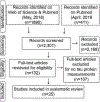The effects of mild closed head injuries on tauopathy and cognitive deficits in rodents: Primary results in wild type and rTg4510 mice, and a systematic review
- PMID: 31930992
- PMCID: PMC7373372
- DOI: 10.1016/j.expneurol.2020.113180
The effects of mild closed head injuries on tauopathy and cognitive deficits in rodents: Primary results in wild type and rTg4510 mice, and a systematic review
Abstract
In humans, the majority of sustained traumatic brain injuries (TBIs) are classified as 'mild' and most often a result of a closed head injury (CHI). The effects of a non-penetrating CHI are not benign and may lead to chronic pathology and behavioral dysfunction, which could be worsened by repeated head injury. Clinical-neuropathological correlation studies provide evidence that conversion of tau into abnormally phosphorylated proteotoxic intermediates (p-tau) could be part of the pathophysiology triggered by a single TBI and enhanced by repeated TBIs. However, the link between p-tau and CHI in rodents remains controversial. To address this question experimentally, we induced a single CHI or two CHIs to WT or rTg4510 mice. We found that 2× CHI increased tau phosphorylation in WT mice and rTg4510 mice. Behavioral characterization in WT mice found chronic deficits in the radial arm water maze in 2× CHI mice that had partially resolved in the 1× CHI mice. Moreover, using Manganese-Enhanced Magnetic Resonance Imaging with R1 mapping - a novel functional neuroimaging technique - we found greater deficits in the rTg4510 mice following 2× CHI compared to 1× CHI. To integrate our findings with prior work in the field, we conducted a systematic review of rodent mild repetitive CHI studies. Following Prisma guidelines, we identified 25 original peer-reviewed papers. Results from our experiments, as well as our systematic review, provide compelling evidence that tau phosphorylation is modified by experimental mild TBI studies; however, changes in p-tau levels are not universally reported. Together, our results provide evidence that repetitive TBIs can result in worse and more persistent neurological deficits compared to a single TBI, but the direct link between the worsened outcome and elevated p-tau could not be established.
Keywords: CTE; Concussion; Neurodegeneration; Rodent behavior; TBI; Tau.
Copyright © 2020. Published by Elsevier Inc.
Conflict of interest statement
Declaration of Competing Interest No competing financial interests exist.
Figures





References
-
- Abisambra JF, Scheff S, 2014. Brain injury in the context of tauopathies. J Alzheimers Dis 40, 495–518. - PubMed
-
- Antkowiak PF, Vandsburger MH, Epstein FH, 2012. Quantitative pancreatic beta cell MRI using manganese-enhanced Look-Locker imaging and two-site water exchange analysis. Magn Reson Med 67, 1730–1739. - PubMed
-
- Augustinack JC, Schneider A, Mandelkow EM, Hyman BT, 2002. Specific tau phosphorylation sites correlate with severity of neuronal cytopathology in Alzheimer’s disease. Acta Neuropathol 103, 26–35. - PubMed
Publication types
MeSH terms
Grants and funding
LinkOut - more resources
Full Text Sources

